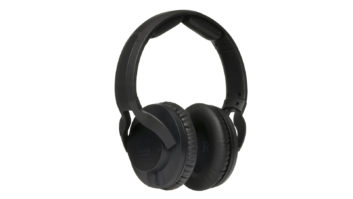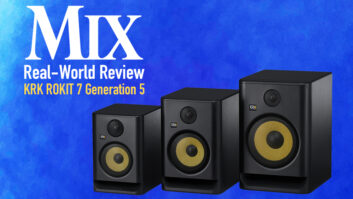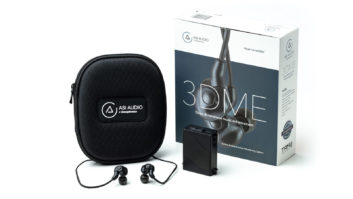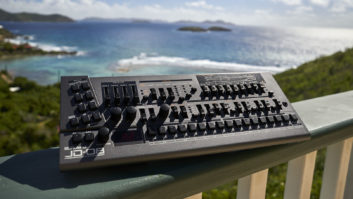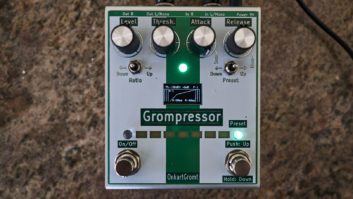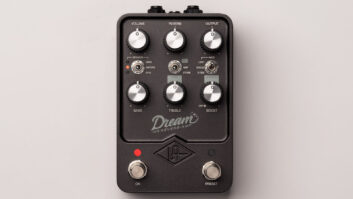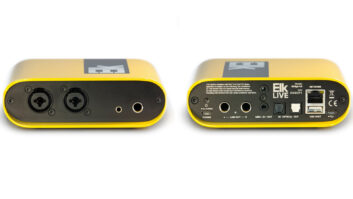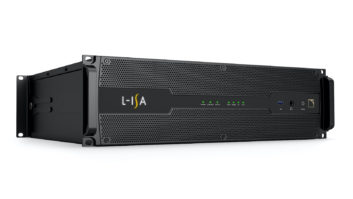What do you do for an encore if you’ve already got the best-selling line of monitors in the world? Ideally, you retain all the desirable traits that got you there, but raise the stakes with improved materials and design.
KRK Systems’ ROKIT G4s build on the success of the best-selling ROKIT G3s: the aramid glass composite woofers and silk-dome tweeters are now Kevlar, though still branded in KRK’s trademark yellow and housed in a plastic composite cabinet so things don’t look that different. Under the hood, there’s new amplification, new DSP and new control (the KRK Control app) for what is really an all-new active studio monitor that somehow manages to sound quite a bit like its successful predecessors … but just a little better.
Out of the Box
The ROKIT G4 line includes 5-, 7-, 8- and 10-inch models. The ROKIT 8 G4 is a two-way nearfield studio monitor with a frequency response of 36 Hz – 40 kHz, max SPL of 111 dB and power output of 203W; ROKIT 10-3 G4 is a three-way midfield studio monitor with a frequency response of 26 Hz – 40 kHz, max SPL of 112 dB and power output of 300W.
Like KRK’s flagship V Series monitors, the G4s (I tested the ROKIT 8 G4) use the same Kevlar material for the woofer and the tweeter because of its rigidity and excellent strength-to-weight ratio. According to KRK, using the same materials to deliver all frequencies creates a more uniform response and a natural tonal balance, resulting in less listener fatigue.

The low-resonance plastic composite cabinet has a newly-designed and larger front port, which offers greater placement flexibility than rear ports. Here, KRK used “computational fluid dynamics analysis to ensure laminar airflow for reduced port turbulence and optimized low-frequency transient response.” The base of the cabinet has an open-cell iso-foam pad footer that helps decouple the monitor from its support.
Amplification is provided via new internal Class-D type amplifiers, an efficient design that has become common in modern powered monitors due to reduced heat creation and lighter weight. Inside the ROKIT 8s, 203 watts are delivered, creating a max SPL of 111 dB. The rear panel is sparse, with only a power switch, IEC power connection, combo analog input and the screen/dial for the DSP control.
Via this single knob, you can scroll/tap through numerous settings, especially the new digital EQ. It is not infinitely variable in its settings but instead offers 25 presets to cover most needs with (boosted or cut) high and low shelves, as well as high-mid and low-mid bell curves at fixed frequencies (not sweepable or parametric). The KRK Brick Wall Limiter is always on, protecting the drivers by preventing amplifier overload. A power standby mode is offered that engages after 30 minutes of inactivity.
In Session
Even though I have never owned a KRK monitor other than the 10S subwoofer, I’ve often used the G3 as my standard for very affordable monitors. In my comparisons, it seemed that the G3s had the most consistent and complete bottom-end response, and often the most punch, too; you could say that the KRKs “rocked” more than their competitors in the low-price category.
KRK seems to be continuing the trend with the G4 models, as the 8s deliver some serious bottom end for their size. No, they aren’t full bandwidth down to 20 cycles, nor do they preclude the need for a sub in serious applications, but the depth and punch they deliver is commendable. In particular, KRK is not kidding about Kevlar being light and rigid; you can hear it in rapid kick drums or tom-toms, as the transients remain distinct and the woofers seem to recover quickly enough to deliver the next blow separately from the preceding and following hit.
These are punchy speakers—punchier than most—and they’re able to deliver that detail in the realms of loud and very loud before they start to compress; and finally the limiter kicks in, not so much with a bark as with blur and sag. Unfortunately, there is no visual indicator of the limiting kicking in, which would be helpful. That said, they are loud as hell by that point. You should be able to work in smaller rooms without ever hearing the limiter. The front ports work without audible issues and are apparently well matched to the woofers/amps/cabinets, encouraging this impressive bass and dynamic response.
The overall tonal balance isn’t bottom, however, as those tweeters deliver offsetting top-end—maybe even a bit much of it, really, as there is a lot of energy in the 3 kHz to 6 kHz region, making for exciting and detailed sound. Above 6 kHz, the response is notably flatter and distributed around the room quite uniformly, with a circular wave guide for the tweeter. This guide isn’t very pronounced and allows equal dispersion in all directions, resulting in a rather wide sweet spot—so there are no issues with ear placement on the vertical axis, but potentially a problem for low and untreated ceilings, very reflective flooring or iso-booth glass.
Before doing any work with the 8s, I broke them in with some catalogue listening. I found them consistently deep-reaching, consistently forward with those hi-mids, and sometimes noticeably scooped in the just-under-1 kHz midrange area. This frequency range is also home to a bit of cabinet honk (a common trait with less-than-massive modern cabinetry), so a bit of a frequency dip in this area was necessary, even if it creates some inconsistencies.
I first tried EQ’ing myself and found I liked the extra boom from a +2 dB bass boost; that helped offset the abundant high-mid emphasis, but it was just a little too tubby. I tried the -2 dB bell-curve cut with the high-mids but that was a little too empty for me, so I tried the -2 dB high-shelf cut, which was a little too dull. I found myself really preferring the monitors flat, even if a little imbalanced, as they seemed the most natural, dynamic and complete that way.
KRK’s Audio Tools App (tested with iOS here, to be reviewed here soon) aids in positioning and calibration; for ROKIT G4s only, it provides EQ settings recommendations. The app recommended a flat setting for me, so I think it’s pretty accurate and could be much more helpful to those in need.
The Final Mix
In my studio, the ROKIT G4 8s were ample help as a second point of reference and especially for gauging tricky bottom-end EQ adjustments, responding with detail and sensitivity. With a little practice, I do think I could work on them alone, and I think they’ll be more than adequate for their intended audience: engineers getting their first or second pair of serious monitors. I can’t think of any other monitors at this price point that can deliver this much SPL, this much punch and dispersion this smooth, even if the EQ isn’t the best sounding. I’d expect the G4 line to keep up with its G3 predecessors in popularity, even as the affordable nearfield market heats up with worthy competition.
KRK Systems • www.krksys.com
